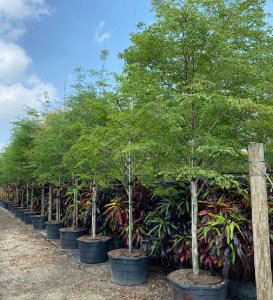Gardening in the shade? A key reason for planting trees, especially in the subtropics and tropics, is to create shade and provide a welcome refuge from direct sunlight for humans and animal, as well as to cool structures. But there is a down side to shade, with respect to growing other plants beneath the trees. In trees with dense canopies, light intensities at ground level can be very low and represent a challenge to landscaping.
Understanding Illumination Levels for Shade Gardening
Plants that grow best in shaded environments are known as sciophytes, the opposite of those thriving in full sunlight which are called heliophytes. With respect to optimal illumination levels, plant habitats are defined as follows. Full sun, refers to an average of 6 full hours of direct sunlight. Partial sun/partial shade, indicates conditions of 3-6 hours of daily sunlight. Light shade is often used to refer to partial sun conditions. Dappled (filtered) sunlight is similar to partial shade with the addition of specs of direct sunlight penetrating through the tree canopy.
Over the course of the day the light specs move eastward across the ground. This level of shade presents understory plants in an especially beautiful setting. Full shade designates 3 hours or less of direct sun, typically at a low angle, either morning or afternoon. Deep shade defines conditions where direct sunlight seldom if ever reaches the ground. In nature, for example, this occurs in dense coniferous forests. These designations vary with latitude because solar intensity increases steadily from the poles to the equator. Another factor is topography such as a hill or mountain which may reduce the incidence of direct sunlight hours; similarly, the presence of a building can create atypical shade conditions. For example, a structure facing south will have markedly different shade conditions to the north and south.
Gardening in the Shade for Successful Landscaping
Successful landscaping of a shaded environment entails a determination of the shade levels present in different parts of a garden, and then matching those conditions with plants which will perform well. Gardening options are greatest under trees casting light shade, diminishing as the level of shade increases. Plant descriptions often include information about the growth of grass, flowers, ground covers and shrubs in shaded areas. In general, the spread of a tree canopy corresponds to the extent of its root system. Therefore, gardening or any other soil disturbance may negatively impact the tree.
Following are a few ideas for gardening in the shade. In South Florida, some cultivars of St. Augustine grass are shade tolerant. If the shade is too severe for grasses, there are several types of ferns which do well under limited light. Bromeliads are another attractive option, some species will grow in deep shade.
In a situation where dense shade is presenting planting difficulties, this can be remedied somewhat by lifting and/or thinning out the canopy to permit more direct or indirect sunlight to penetrate through to the ground. A modification of the canopy to change the environment from full shade to partial shade can open up new planting possibilities of gardening in the shade.
Contact us for more information!
Check out also: Best tree for shade!



Post a comment